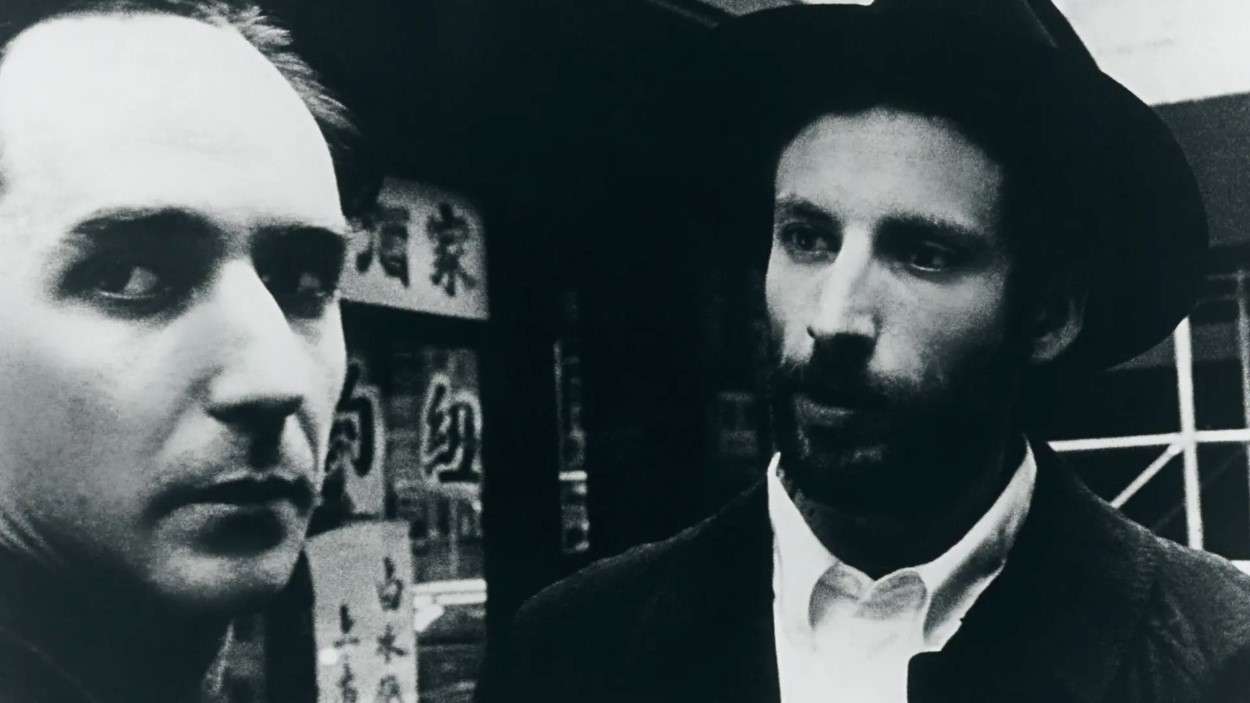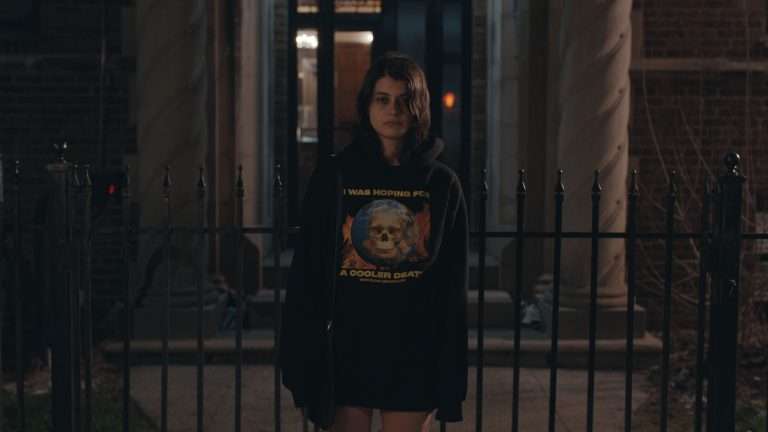“Pi” (1998) Movie Ending Explained: In 1998, two extraordinary filmmakers of the 21st century made their feature-film directorial debut with ultra-low-budget indies shot in black-and-white. One is Christopher Nolan (“Following”), and the other is Darren Aronofsky (“Pi”). While “Following” is a neo-noir crime thriller, “Pi” is a psychological mystery/drama with an intense, disorienting atmosphere that reminds us of David Lynch’s “Eraserhead” (1978) and Shinya Tsukamoto’s “Tetsuo: The Iron Man” (1989). Nevertheless, despite their contrasting filmmaking styles, Aronofsky and Nolan’s films share one recurring theme: obsession. In fact, “Following” and “Pi” follow protagonists spiraling into the depths of obsession, although their temperament and life journey are totally different.
“Pi” (1998) was made on a budget of $60,000, raised as individual contributions from Aronofsky’s friends and family. Shot in grainy, high-contrast black-and-white, the film chronicles the emotional unraveling of a mathematical genius. Although math can be an esoteric and head-scratching topic in movies, through the math genius’ wild quest to understand the universe through numbers, Aronofsky crafts a compelling and layered study of madness and mysticism. “Pi” (1998) premiered at the Sundance Film Festival, and Aronofsky won the Director’s Award and also secured a distribution deal with Artisan Entertainment. Now, let’s delve into the smart and frenzied narrative of “Pi,” which has garnered a cult following since its release. Spoilers Ahead.
Pi (1998) Movie Plot Explained:
Who Is Maximilian Cohen?
“Pi” (1998) revolves around unemployed and solitary mathematician and number theorist Maximilian Cohen (Sean Gullette – also contributed to the story). He lives in a dreary apartment in Chinatown, Manhattan. His apartment is primarily occupied with a high-powered, homemade computer, which Max has named “Euclid.” He hopes to customize Euclid to make stock predictions. Max’s minimal social interactions and his voice-over narration tell us that his focus on numbers borders on obsession. Everything is not alright with Max as we first see him waking up with a nosebleed. He suffers from cluster headaches, has seizures, and often passes out.
Max tries to avoid his neighbors, which is evident in the way he looks at the peephole before getting out of his home. Yet, Max often comes across two people in the apartment complex: Jenna (Kristyn Mae-Anne Lao), a little girl exhilarated by Max’s ability to casually solve complex mathematical calculations (she carries a calculator with her to compare the answers); and Devi (Samia Shoaib), a young woman living next door. Devi shows concern for Max’s well-being, and she is interested in him, although he doesn’t seem to pay attention. Later, during one of his ‘episodes,’ Max envisions Devi’s warmth and pleasure-seeking nature as something that can provide him solace, although, in reality, he perceives her as a sort of disruptive force.
Max’s Search for the Meaning Through Numbers
Max firmly believes that mathematics is the language of nature and the universe. Hence, he seeks to find order in the chaos through numbered patterns. As Max walks in the crowded streets or sits alone in a park staring at the trees, he aspires to unlock the patterns in the universe through numbers. But Max first wants to test his theory by making Euclid spit out the pattern in stock markets. This catches the attention of a Wall Street firm, and a woman called Marcy Dawson (Pamela Hart) keeps calling Max, even though he invents excuses to avoid her.
Later, Max goes out to a diner. While focusing on the stock market numbers, Max is interrupted by Lenny Meyer (Ben Shenkman). Lenny is a Hasidic Jew who also exhibits a keen interest in number theory. However, Lenny’s interest in numbers is related to his mathematical research on the Kabbalah – a school of thought in Jewish mysticism intent on unlocking the secrets of the ancient holy text. As Lenny tries to make a conversation, Max feels the signs of another attack. Hence, he goes home and takes his pills. Yet the attack isn’t averted. Before passing out, Max has a hallucinogenic vision of someone trying to break into his apartment.
What does Euclid Print before Malfunctioning?
He wakes up with a nosebleed, and after cleaning up, Max goes to meet his mentor, Sol Robeson (Mark Margolis). Sol is the only person with whom Max voluntarily has an interaction. Sol is disabled by a stroke, and they play a game of Go. He asks Max to take a break and not burn himself out. Sol himself had been an obsessed mathematician, trying to search for patterns in Pi. At the diner, Max once again meets Lenny. He explains how the ancient Jews used Hebrew as their numerical system, and he demonstrates how each letter is a number and how the combination of letters, i.e., words, contains a precise numerical value.
Lenny says the Torah – the holy book of Judaism – is a long string of numbers and a code sent from God. Max looks intrigued. He also notes how certain concepts Lenny posits have parallels in mathematics, like the Fibonacci sequence and spirals. When Lenny also emphasizes Max’s firm belief (“Math is everywhere”), Max intently sits in front of Euclid to work on the stock predictions. Unfortunately, the Euclid malfunctions. It prints out a single stock pick, followed by a seemingly random 216-digit number before shutting down. Max finds Euclid’s prediction of AAR stock impossible since the company hasn’t reached that value in two decades.
Did Euclid make an Accurate Stock Prediction?
Max gets frustrated while trying to repair Euclid. He also throws out the 216-digit number. Subsequently, he speaks out about Euclid’s malfunction with Sol. The veteran mathematician is eager to know about the random numbers. He questions how many digits it had. When Max says it might be around 200, Sol says he had some bugs during his Pi research and wonders if the number is the same. Sol also tells a story about mathematician Archimedes’ Eureka moment, emphasizing that he got his break in his research while relaxing. Likewise, Sol entreats Max to loosen up.
During his trip back home in the subway, Max finds a newspaper and checks the stock section. The AAR stock is precisely at the same value Euclid predicted. By this time, Max has started experiencing things that might not be real. He keeps seeing an older man in the subway car and thinks he is following him. In the subway station, Max sees a guy wearing a hat with blood dripping from his hand. While navigating his way home through this paranoia-infested atmosphere, Max comes across Marcy Dawson, but he runs away from her.
After confirming the stock value in another newspaper, Max looks for the paper containing the 216-digit number. But he can’t find it in the trash. Max runs into Lenny on his way home, who invites him to his synagogue (Shul). He goes with him to avoid Marcy waiting in front of the apartment. At the synagogue, Max learns that Lenny is also looking for a pattern in the Torah, which is 216 digits long.
Is the 216-digit Number the Key to Unlocking the Underlying Pattern?
Max inquires Sol about the 216-digit number, recalling his meeting with the Hasidic Jews and the AAR stock price prediction. Sol dismisses it as a coincidence and considers the bug he had during his Pi research might not have anything to do with the number Euclid had to spit out. Sol tries to explain our world’s complex, chaotic nature through the Go game board. He says although the board looks empty, simple, and ordered before the game, as the game progresses, there are endless possibilities and patterns that can’t be summed up by math. However, Max argues that though the possibilities might be endless, a pattern will emerge if keenly observed. Max reiterates his belief that there’s an underlying pattern in everything, whether a Go game, the stock market, or the universe.
Sol warns that this line of thinking will lead Max to madness. He says if Max filters out the scientific quest and starts obsessing with the 216-digit number, he will see it everywhere in nature and his life. And Sol insists that discarding the scientific approach will only turn him into a numerologist. Back at his apartment, Max is once again ambushed by Marcy. He shouts at her that he isn’t trying to unlock the stock market pattern for financial gain. But Max is taken aback when Marcy Dawson offers him a new, classified computer chip called “Ming Mecca.” In exchange for the chip, she seeks access to the result of his work.

What is Max’s New Hypothesis?
Soon, Max feels the beginnings of another attack. He runs to the subway station. There, Max once again has a vision of the hat guy with blood dripping from his hand. He goes after the guy, only to find a pulsating brain on the steps of the subway platform. He prods the brain with his pen and turns to see the blinding light of an approaching subway train. Max wakes up from the hallucination at a subway car, his nose bleeding. Later, Max is seen at the seashore. He picks up a seashell and finds the spiral pattern, which probably makes him think of the Golden Ratio and the Fibonacci Spiral.
Back at home, while looking at his computer chip, Max finds a slimy substance atop it. He puts that substance in a microscope, and guess what? He sees the spiral pattern in it, too. From Pythogaras to Da Vinci, Max speaks of the great figures who are long associated with the Golden Ratio. He comes up with his new hypothesis that since we live in a giant spiral (our Milky Way galaxy itself has a spiral structure), everything we do is infused with the spiral.
Did Max become Clairvoyant?
Max calls Lenny and meets him at the diner. He inquires Lenny about what the 216-digit number means in Hebrew. Lenny answers he doesn’t know and asks Max’s help to find it. Later, Max receives the “Ming Mecca” chip. He reboots Euclid and tries to analyze the mathematical patterns in the Torah. However, his headaches intensify. In the bathroom mirror, he sees a bump protruding from his right temple and attempts to cut it out. But in the pain, he smashes his head against the mirror. He walks out of the bathroom to see Euclid once again on the verge of crashing. It is typing the 216-digit number. When Max presses the print button and isn’t able to print it, he starts noting down the numbers.
After a while, he stares at the numbers as if he has had an epiphany and can predict the pattern in the numbers. But he loses consciousness, and when he wakes up, Devi and a few other neighbors are in his apartment. Max chases them out. Later, he shaves his head, standing in front of the broken bathroom mirror, and draws a rectangle around the bulge in his temple – a hint that Max is ‘seeing’ a pattern everywhere, like Sol said. Now, Max thinks he has become clairvoyant as he visualizes the stock market patterns before they are displayed.
What does the Rabbi want from Max?
Max confronts Sol, claiming he lied about the 216-digit number. But Sol dismisses the number as a bug. Sol says before crashing down, the computer simply prints out its ‘ingredients,’ which doesn’t mean anything. However, Max argues the number is a door to something more significant. Once again, Sol asks Max to quit his work since it’s not doing him any good. On his way home, Max sees someone photographing him in the subway station. He chases after the guy and forcefully takes the film out of the camera. Max believes someone has hired the photographer to follow him, whereas the young guy says he was taking pictures for his class assignment.
Marcy Dawson and her men grab Max on the street. She has retrieved the 216-digit number from the trash, but she says using the number to play the market has only caused them to crash the market. Marcy thinks this is only part of the code. Lenny, driving by, saves Max from Marcy and her goons and takes him to the synagogue. There, Max is intimidated by Rabbi Cohen to give him the number. The Rabbi believes the number will lead them to the word, which is the true name of God. He says the number was meant for them to usher in the ‘Messianic Age.’ Now, Max’s delusions proliferate as he thinks the number was revealed only to him and it holds the key to the universe’s DNA.
Pi (1998) Movie Ending Explained:
What Happens to Max in the End?
Max flees from the synagogue and goes to meet Sol. His daughter tells him that Sol had another stroke and died. In the living room, Max picks up a piece of paper where Sol has written down the 216-digit number, and the Go board pieces are arranged in a spiral shape. This implies that Sol tried to look into the 216-digit number. Perhaps Sol’s curiosity after his argument with Max led him to do it, and it might have caused his second stroke, claiming his life. At his apartment, Max suffers from headaches. He doesn’t take the painkillers and smashes the whole Euclid system. Before passing out, he focuses on the number. Max envisions himself standing in a white void, reciting the digits of the number. He wakes up with Devi hugging him, telling him, “It’s all right,” but this turns out to be a hallucination.
Standing before the broken bathroom mirror, Max burns the paper with the 216-digit number. Then, he uses a drill on his head near the bulge. Later, we see Max calmly sitting in the park. We might wonder how Max survived the self-trepanning and if his drilling a hole in the head is also a hallucination. The drilling imagery can simply illustrate that Max was meddling with his head/mind, which has led him to a dead end. Max’s recurring visions of the brain itself indicate the externalization of Max’s self-torture of his mind. Nevertheless, when Jenna approaches Max in the park with a calculator in her hand, he looks serene and at peace.
Did Max Lose his Gift?
Like before, the little girl tests him with mathematical problems that must be simple to Max. However, Max says he doesn’t know and looks as if he has lost his mathematical abilities. She further asks him a division question (748 ÷ 238 – the answer is an approximation for pi). But Max doesn’t have an answer as he enjoys the breeze and stares at the tree. Did Max lose his gift (or the curse) alongside his headaches? The ending might seem a bit hopeful as a more relaxed Max has another chance at life. At the same time, it feels like a warning about the fine line that separates genius and madness. Despite dealing with numbers, patterns, and mysticism, “Pi” is truly about obsession and how it can destabilize an individual.
On three occasions, Max mentions (in a voice-over) a childhood incident when he stared into the sun despite being asked not to do that by his mother. His eyes did heal, and gradually, the darkness was displaced by the light. Yet, Max says this was the origin point of his headaches. On another occasion, Sol likens Max’s obsession with that of Icarus – the son of an Athenian craftsman in Greek mythology, whose wings melt when he flies too close to the sun. Hence, metaphorically, Max, like Icarus, driven by his obsession, thinks he is on the verge of discovering the unknowable or the obscure, leading to his mental breakdown.
Overall, “Pi” (1998), with its unsettling camera work, haunting score, and layered narrative, offers a tense and singular movie experience. Darren Aronofsky’s reference to Jewish mysticism and the Abrahamic religions would persist in his subsequent works, including “The Fountain,” “Noah,” and “mother!”



![The Matrix Resurrections [2021] Review – A Romantic Heist Film That Has a lot to say about Nostalgia, Freedom and Choice](https://79468c92.delivery.rocketcdn.me/wp-content/uploads/2021/12/The-Matrix-Resurrections-768x384.jpg)



![Trial on the Road [1971] Review – A Searing Examination on the Thin Line of Demarcation between ‘Hero’ and ‘Traitor’](https://79468c92.delivery.rocketcdn.me/wp-content/uploads/2019/08/Trial-on-the-Road-1971-768x432.jpg)
